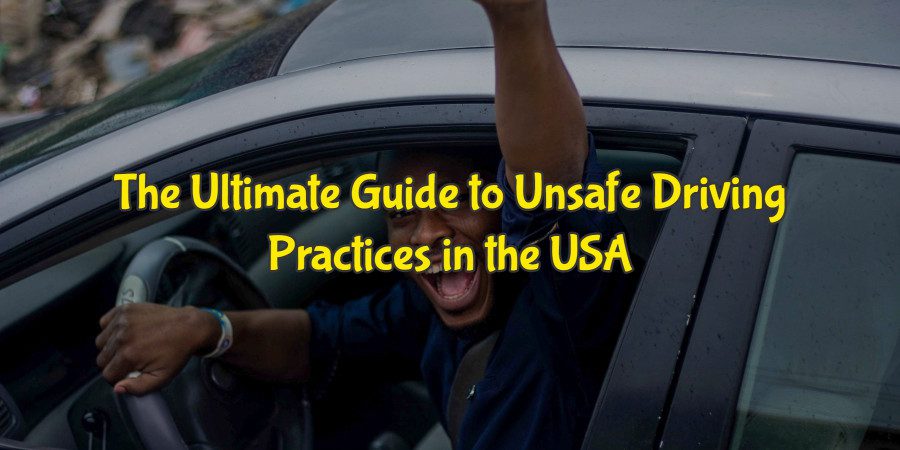
Are you aware of the unsafe driving practices that can put you and other drivers at risk on the roads? If not, you’re in the right place. In this comprehensive guide, we’ll walk you through the most dangerous driving practices in the USA that you need to avoid. From distracted driving to reckless driving, we’ll cover it all. So, buckle up and let’s get started.
The Importance of Understanding Unsafe Driving Practices
As a driver, it’s crucial to understand the consequences of unsafe driving practices. Not only do they put your life in danger, but they can also cause serious harm to others on the road.
According to the National Highway Traffic Safety Administration (NHTSA), in 2019, there were 36,096 fatalities on the roads in the USA, with the leading causes being distracted driving, speeding, and drunk driving.
By avoiding these unsafe driving practices, you can help reduce the number of accidents and save lives.
Distracted Driving
Distracted driving is one of the most dangerous driving practices in the USA. It involves any activity that takes your attention away from the road, such as using a cell phone, eating, or adjusting the radio.
According to the NHTSA, in 2019, distracted driving was responsible for 2,841 fatalities on the roads. To avoid distracted driving, it’s important to put away your phone, avoid eating or drinking while driving, and program your GPS before you start driving.
Reckless Driving
Reckless driving is another unsafe driving practice that can lead to accidents and fatalities. It involves driving in a manner that disregards the safety of others on the road, such as speeding, tailgating, and weaving in and out of traffic.
According to the NHTSA, in 2019, reckless driving was responsible for 9,466 fatalities on the roads. To avoid reckless driving, following the speed limit, keeping a safe distance from other vehicles, and avoiding aggressive driving is important.
Drunk Driving
Drunk driving is a serious offense that can result in severe consequences. It involves driving with a blood alcohol concentration (BAC) of 0.08% or higher, which impairs your ability to drive safely.
According to the NHTSA, in 2019, drunk driving was responsible for 10,142 fatalities on the roads. To avoid drunk driving, it’s important to never drive after drinking alcohol, designate a sober driver, or use a ride-sharing service.
Speeding
Speeding is a common driving practice that can increase the likelihood of accidents and fatalities. It involves driving above the posted speed limit or too fast for the conditions.
According to the NHTSA, in 2019, speeding was responsible for 9,478 fatalities on the roads. Following the posted speed limit and adjusting your speed based on the road conditions, such as weather and traffic, is important to avoid speeding.
Running Red Lights and Stop Signs
Running red lights and stop signs is a dangerous driving practice that can lead to accidents and injuries. It involves ignoring traffic signals and driving through an intersection, even though you must stop.
According to the NHTSA, in 2019, running red lights and stop signs was responsible for 846 fatalities on the roads. To avoid running red lights and stop signs, it’s important to always come to a complete stop at intersections and wait for the green light or stop sign before proceeding.
Fatigued Driving
Fatigued driving is a dangerous driving practice that can lead to accidents and fatalities. It involves driving when you’re too tired to focus on the road. According to the NHTSA, in 2019, fatigued driving was responsible for 697 fatalities.
To avoid fatigued driving, it’s important to get enough sleep before driving, take breaks when needed, and avoid driving during late-night hours.
Tailgating
Tailgating is another unsafe driving practice that can lead to accidents and injuries. It involves driving too closely to the vehicle in front of you, which reduces your reaction time and increases the risk of a rear-end collision.
According to the NHTSA, in 2019, tailgating was responsible for 2,098 fatalities on the roads. To avoid tailgating, it’s important to keep a safe distance from the vehicle in front of you and avoid driving aggressively.
Improper Lane Changing
Improper lane changing is a dangerous driving practice that can cause accidents and injuries. It involves changing lanes without signaling or checking blind spots, which can result in a collision with another vehicle.
According to the NHTSA, in 2019, improper lane changing was responsible for 547 fatalities on the roads. To avoid improper lane changing, always use your turn signal when changing lanes and check your blind spots before making a move.
Failure to Yield
Failure to yield is another unsafe driving practice that can lead to accidents and injuries. It involves failing to yield the right of way to other vehicles or pedestrians when required, such as at a stop sign or crosswalk.
According to the NHTSA, in 2019, failure to yield was responsible for 3,719 fatalities on the roads. To avoid failure to yield, always pay attention to traffic signs and signals and be aware of other vehicles and pedestrians around you.
Conclusion:
Unsafe driving practices can have serious consequences, including accidents and fatalities. By understanding the most dangerous driving practices in the USA, such as distracted driving, reckless driving, drunk driving, speeding, and running red lights and stop signs, you can avoid them and make the roads safer.
In addition to avoiding unsafe driving practices, it’s also important to maintain your vehicle and practice defensive driving. Regular vehicle maintenance, such as checking your brakes, tires, and lights, can help prevent accidents caused by equipment failure.
Defensive driving techniques, such as keeping a safe distance from other vehicles and anticipating potential hazards, can also help you avoid accidents on the road.
Overall, staying informed and taking proactive steps to avoid unsafe driving practices can help make the roads safer for yourself and others. Remember to prioritize safety while driving and never take unnecessary risks that could result in harm or tragedy.
